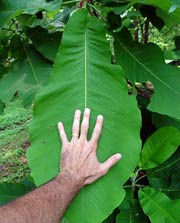
The brightest color in the world. About the world of plants and country life
The vast majority of gardeners, especially summer residents, after the end of the berry picking season, forget about their shrubs until next spring and, at best, feed them after the snow melts with a handful of nitroammofoska or weed them, removing the rapidly growing couch grass. This fate befell the black currant. Although outwardly the culture seems to be a healthy and strong shrub, it also requires care and attention. And especially in the autumn, when there is a long winter ahead.
Lentil cutlets with chanterelles is a delicious, original hot dish that can be served for dinner with a side dish of mashed potatoes and a thick white sauce. If you want to surprise your guests and family, cook these tender meatballs. You can replace chanterelles with champignons, because it is not every month that you will meet in the forest or on the market exactly “forest gold”. I cooked cutlets from Canadian green lentils, they are cooked in about half an hour. Regular lentils need to be soaked in advance.
In the current season, alas, there is no record apple harvest: the rainy and rather cool summer, which looked like a mixture of autumn and spring, interfered. But still, there is a harvest, it is tangible, and if we do not want the harvested apples to spoil in a couple of weeks, they must be properly stored. They say that with proper storage, an apple can lie for several years, retaining its varietal qualities and properties, but why should we wait so long to taste it?!
One of the most original types of indoor blehnum ferns is rightfully considered one of the most capricious. Its thermophilicity and humidity requirements have turned this relic plant into a real legend. Blechnum, or derbyanka in the room - the fern is not for everyone, but it is surprisingly beautiful. Enough large sizes and vayi leaves vaguely reminiscent of palm trees will easily outshine any other decorative leafy plant in your interior.
Zucchini fritters with cheese and garlic are a delicious dish worthy of a Sunday breakfast, especially during harvest season. Pancakes are a useful thing, you can’t prepare them for the future, but you can completely eliminate part of the crop with benefit. For a family of three, one medium-sized vegetable weighing up to 1 kilogram minus cleaning is used. From this amount, you get an impressive appetizing slide of pancakes, which will famously leave with sour cream while watching the Sunday morning show.
Now is the very beginning of autumn, the whole crop has not even been harvested from the site yet. But you may not believe that in order to ensure the harvest of the next season, the vacated soil, for future beds, is already time to start preparing. And this is not a joke at all: you need to prepare this soil correctly so as not to be disappointed in the next year's harvest. How to prepare the beds, how to properly dig and fertilize the most common vegetable crops right now, we will tell you today.
Pickled cucumbers in circles with citric acid are garnish cucumbers, the cooking principle of which I somehow spied on in one TV show. They showed a large factory where cucumbers are pickled for hamburgers. These are really excellent side dishes, which are indispensable in cases of emergency, when there is no time to cook dinner, but you need to feed your family. On a plate with mashed potatoes and sausages, he put a hill of cucumbers with onions - and it's already delicious!
Proper nutrition for indoor plants- one of the factors of their normal development. Fertilizers are often misunderstood as just a flowering or growth aid, but their significance is much more important. Plants obtain substances from the soil and air. But in a limited amount of substrate, they depend on whether top dressing is carried out correctly and what fertilizers are used. For pets, both macro and microelements are equally important.
Homemade tomato juice, in the recipe of which a blender is used, is simple, tasty and within the power of any housewife. I don't use a juicer. Frankly, it's just a pity for the place in the kitchen. This kitchen gadget is needed only a couple of months a year, if you are not a fan of freshly squeezed drinks, and it will take a shelf in the locker firmly and for a long time. An ordinary blender, and in the old days - a simple meat grinder and a sieve, solve the problem of making tomato juice at home.
Potash fertilizers, along with phosphorus and nitrogen fertilizers, are very important for plants, since potassium is a significant element for them, one of the three pillars on which the entire life potential of any organism rests, so the application of potash fertilizers should by no means be ignored, Moreover, there are many fertilizers that contain potassium, and you can choose the most suitable for the type of soil of your site and the plants growing on it.
Colorful symbols of summer, quivering, delicate, and at the same time so hardy, decorative poppies, leave no one indifferent. The inimitable colors and details of the structure of these amazing flowers are an invariable decoration of any garden in the summer. But the cultivation of decorative poppies is not a completely standard task, although not a difficult one. Poppies are propagated by seeds, and the choice of methods and methods of sowing allows everyone to find their own ideal option.
Pickled sweet and sour cucumbers with red currants and onions are incredibly tasty and spicy cucumbers, crispy and appetizing. I really like to diversify pickles with various additives. Everyone likes a pleasant surprise in a jar: either a crispy onion, or a carrot, or a clove of garlic. Redcurrant berries will also come in handy. If you harvested the day before harvesting, then nothing bad will happen to the cucumbers, just wash them cleanly.
Covering roses for the winter should be correct. Resolutely new methods are replacing the old and not always effective methods. But before we talk about the basic principles of proper protection of roses, even in the most severe conditions, we will tell you about the proper preparation of plants for wintering. Choosing the right shelter for roses is a simple procedure. Especially for those who know what requirements it must meet. Do not know? We will be happy to tell you about it.
Everyone understands that a full-fledged potato crop can only be obtained from high-quality tubers that have been selected and stored for planting in the right conditions. Of course, you can always buy seed potatoes in one of the farms, but this is quite expensive, so the gardener often solves this problem himself. So, let's talk in detail and clearly about the technology for selecting seed potatoes, preparing them for storage, as well as about the storage itself.
Among the flowering indoor plants, almost all shrubs have become true legends. But if gardenia or rhododendrons, camellias and roses are everyone's favorites, then abelia is still perceived by many as exotic. These are magnificent plants with a pronounced oriental character, captivating with the density and curly crown, abundance and grace of flowering. Relentless flowering from the second half of summer to mid-autumn can not leave anyone indifferent.
Ten most exotic plants in the worldIN natural conditions not so many of them have survived, some of them are on the verge of extinction. But, if we really want, we will be able to see this exotic with our own eyes. In order for our descendants to have a chance to see these amazing monkey puzzle plants, dragon tree, amazing velvichia, titanium arum, venus flytrap, rafflesia, takka, jade flower, ghost man tree, lacy tree, we must do everything to save them. A dozen exotic plants that reminds us that our world is beautiful and worth loving and protecting.
Puzzle for the monkey. Chilean araucaria.
Araucaria araucana The leaves of this tree are so hard and prickly that birds prefer not to sit on them. That is why the tree has such a strange name: the once proud owner of araucaria, who lives in Cornwall (in the southwest of Great Britain), showing the tree to his guests, said: “Climbing this tree would be a real puzzle even for a monkey”, since then the second name of the tree is "Monkey Puzzle".
At the end of the 18th century, this tree, described by an Italian botanist, was classified as a special genus of pines, but the famous botanist and zoologist Jean Lamarck restored justice, and proved that this separate view trees - araucaria.
Araucaria seeds can be used for food, and it is quite possible that not only natural, but also their special plantings have been preserved - some of them are confined to the ancient sites of the Indians. Araucaria forests develop best on volcanic soils. Trees reach a height of up to 60 m, and a trunk diameter of up to 1.5 m. A young plant is considered up to 150 years of age, and it can grow “in youth” up to 45 cm annually. Older trees grow up to 10-15 cm per year, while the leaves of the tree can live up to 40 years, and the tree itself - up to 2000. In 1796, i.e. 16 years after the discovery of the Chilean araucaria in America, it was already brought and planted in England (the first grown tree lasted almost a hundred years). Later, this araucaria spread widely in Western Europe, while it can be found even in Norway, but in Russia - only in the botanical gardens of the Crimea and the Caucasus.
Dragon tree.
Dracaena draco The dragon tree is a tree of the genus Dracaena of the Agave family. In appearance, it resembles a huge cactus, on the branches of which bunches of very sharp leaves grow. If an incision is made on a tree trunk, red resin will come out of it - “dragon's blood”.
Even the ancient inhabitants of the Canary Islands - the Guanches - considered the tree sacred, and the resin was used for medicinal purposes. The tree reaches a height of 20 m, and its trunk diameter is up to 4 m. The dragon tree grows in the Canary Islands and Socotra and can live up to 5-6 thousand years, however, annual rings do not form in the tree trunk, and it is not possible to determine its age exactly so simple. The oldest dragon tree grows in a small park (Parque del Drago) of the town of Icod de los Vinos in Tenerife, it is about 2500-3000 years old, if this is true, then this is the oldest known tree on the planet. And the most famous was a tree in the city of La Orotava. it grew to 21 meters, the girth of its trunk was 13.5 meters, and its age was determined at 6000 years, but in 1868 it was knocked down by a hurricane.
Velvichia is amazing.
Welwitschia Mirabilis About a hundred years ago, the German botanist Welwich traveled through the deserts of southwestern Africa and found a plant that looked like a pile of garbage from a distance. This is not a tree, not a bush, not a grass, but something completely peculiar. Its trunk, similar to a stump, grows up to half a meter in height and up to 1.2 m in diameter.
A fleshy taproot up to 3 m long departs from the trunk, which serves to store nutrients and strengthen the plant, and not to obtain water. Velvichia grows in southern Angola and in Namibia, where not a drop of rain falls for months, and sometimes for years.
The plant receives moisture from the fogs that envelop the coast for almost 300 days a year, which is why no one has met Velvichia beyond the fog strip penetrating deep into the territory 80-100 kilometers from the ocean coast. Velvichia leaves are up to 2-3 m long and up to 30 wide. cm persist throughout the life of the plant, although the winds turn them into bast, and some leaves may gradually die off. Radiocarbon analysis has shown that Velvichia can live up to 2000 years, so its leaves are the longest-lived leaves known.
Titan arum.
Titan Arum In Latin, the name of this flower sounds like "a huge deformed penis", it is also called the "corpse flower" (in the local language - bunga bangkai) the plant emits a strong smell of rotten meat, the aroma of which attracts flies for pollination.
The birthplace of the titanium arum is the western part of the island of Sumatra in Indonesia, was discovered in 1878. Today it is considered the most big flower in the world, blooms three times a year. The bud opens for about 3 weeks, and blooms for only a day or two.
Titanium arum belongs to the oldest and most beautiful family of flowering plants - aroid, it can reach a height of 2-3 m, and its weight is up to 100 kg. Titanium arum is a rare flower, it is difficult to grow it, and you can see it in only a few botanical gardens in the world, where flower lovers from all over the world come especially to bloom arum.
Venus flytrap. Venus Flytrap.
Dionaea muscipula This is the most famous carnivorous plant on the North American continent. The size of an adult plant does not exceed 15 cm, but at the same time it easily catches and assimilates mosquitoes, flies and other insects - the flycatcher is able to slam the leaves in one tenth of a second.
This is one of the fastest movements that plants can make. Harvard scientists believe that the leaves of the Venus flytrap accumulate elastic energy, and work on the principle of unstable convex membranes - you just need to press them with your finger, as they switch from one position to another.
Insects touch the trigger hairs of the plant, in response, it slightly loses moisture, because of this, the curvature of the surface changes - and the leaf abruptly closes the trap. That is why to avoid the fate of being eaten more in the smallest insects.
If the insect is “unlucky”, digestive juices are secreted from the glands located on the internal surfaces in such an amount that the insect completely drowns in this liquid. The trap remains closed for several days, and when it finally opens, all that remains of the poor fellow is an undigested chitinous shell.
Rafflesia.
Tiny rafflesia seeds - no larger than a poppy seed - are carried by animals that have stepped on the fruit of the plant. They are introduced under the bark of vines, and after a year and a half the bark swells, forming a kind of bud that ripens after 9 months into a bud of rafflesia - "bunga patma" (in the local language - a lotus flower). The average flower in diameter reaches 70-90 cm, the size of the flower - record holder - 106.7 cm. The thickness of the middle petal is 3 cm, and the length is 46 cm. After a short period of flowering, rafflesia decomposes within a few weeks, turning into a disgusting shapeless mass of black.
Tacca.
Tacca Chantrieri In tropical countries, tacca grows in open field- on sea coasts and in mountainous tropical forests, preferring a humid atmosphere. The local population calls this plant "black lily", "bat" or "devil's flower", associating terrible legends with it, but at the same time, the pulp of takka fruits is eaten, hats and fishing tackle are made from its stems, and flour is prepared from rhizomes for baking bread, sweets, medicines.
Takka contains alkaloid substances and is used in magical rituals. Dried takka flower powder also has interesting properties- it has a very high coefficient of volumetric expansion. Once in the stomach, it increases in volume up to 80-100 times its original volume.
The dark color of the flower is due to the fact that it is pollinated by carrion or dung flies, which are attracted by rotting remains. Insects are attracted by the shine of the cells on the “bottom” of the flower and the very faint smell of spoiled meat, almost imperceptible to humans. In nature, individual specimens reach 3 m in height. In Europe, these exotic plants are grown in winter gardens and greenhouses. Almost bloom and bear fruit all year round. Insects are attracted by the shine of the cells on the "bottom" of the flower and the very faint smell of spoiled meat, almost imperceptible to humans. In addition, flies are attracted by large bracts in which you can spend the night, and juicy filamentous appendages - a real delicacy for insects.
Jade flower.
Green Jade Flower This rare flower grows in the Waipio region along the north coast of Maui (Hawaii) - in the Haiku region.
From it, the local population, according to the traditional Hawaiian custom, makes fantastically beautiful lei - flower garlands that are worn around the neck.
A jade flower is very suitable for this - it remains just to connect the inflorescence decorating the vine of a tree into a lei. The greenish-blue color of jade flowers seems artificial. Incredibly, this is their natural color.
Ghost people. Pachypodium namakvansky. Halfmens. Pachypodium namaquanum On dry rocky hills near the Orange River in Namaqualand and southwest Africa, these succulent trees of the apocynaceae family grow up to 1.5-2 m high. The local population calls them "ghost people" or halfmens (translated into English , like "half human".
This succulent has an unbranched trunk, grayish-green velvety leaves are crowded at the tops, quickly fall off. The crown is always inclined to the north (that is, to the sun, since this is a plant of the southern hemisphere).
The legend says that once the Khoisan Bushmen ("kho" - "man", "san" - "Bushman") were expelled from their native lands (Kalahari Desert) by other tribes. They left with a heavy heart, constantly looking back at the places dear to their hearts and gradually turned into halfmens, while the crown of the trees is always facing north, dreaming of the day when they can return to their beloved homeland.
Lace tree. Bois Dentelle.
Elaeocarpus bojeri It is said that the island of Mauritius was created before God created paradise, he served as a model for it. There are practically no forests left in Mauritius, but beautifully flowering trees and shrubs grow here in abundance, many of them are unique. For example, a talipo tree, reaching a height of 28 m. It blooms once every 60-100 years, blooming many inflorescences, and then quickly dies. Even more rare plant is bois dentelle. There are only two of them in nature.
Its flowers are beautiful - splashes of white inflorescences with amazing lacy petals, they cover the tree from January to March. Its closest relative, Elaeocarpus serratus (bois d'olive), is native to India. The pulp of the fruit of the tree is edible and was most often used for pickling.
The government and non-governmental organizations are working together to save the lace tree from extinction. One of them was planted in a nursery under the patronage of the government, and from the seeds of this tree, two more shoots of the lace tree were able to grow. In addition, attempts are being made to graft its branches to the related variety elaeocarpus serratus - this experience has also been successful. But the danger that our descendants will never be able to see the lacy tree has not yet passed.
Heliconia (Heliconia) symbolizes the extravagance and abundance of the tropics. Its unusual appearance makes the traveler freeze on the path, and gardeners are still racking their brains over the secret of its origin. But heliconia impresses not only with its richness of shapes and sizes, but also with its unusual history.
The east coast of Oahu, Hawaii is a tropical paradise with endless blue skies, gentle waves, fiery sunsets and miles of sandy beaches. It is here that you can find heliconia. Ever since it was introduced to Hawaii, heliconia has thrived in tropical climates. Today, Hawaii is leading the world in the cultivation of this plant.
The name "heliconia" comes from Mount Helikon in northern Greece. The ancient Greeks believed that the Muses lived on it and this indicates a close relationship of helliconia with the genus of bananas, the Latin name of which is ‘musa’.
Plants with large leaves.
 Plants with large leaves look unique, tropical and will add a special touch to any garden. The most common in the world are butterbur, rhubarb, gunnera, and several other plants.
Plants with large leaves look unique, tropical and will add a special touch to any garden. The most common in the world are butterbur, rhubarb, gunnera, and several other plants.
Japanese butterbur (Petasites japonicus)
Japanese Butterbur is a common plant with large leaves native to Japan and also found growing wild in Korea and China. Before the appearance of large leaves, the plant forms small flowers that grow in a group. Butterbur grows well in partial to full shade, and evenly moist soil. With little watering in full sun, the plant will begin to wilt. It is an excellent plant for the banks of large ponds and swamps. Under good living conditions, it multiplies very quickly. To prevent the plant from spreading too much, it can be grown in large pots or other containers.
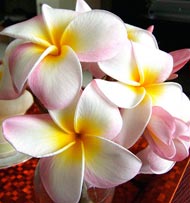 Libraries are decorated with gift editions about plumeria. There are hundreds if not thousands of books, articles and websites dedicated to this beautiful and fragrant flower. There are organizations dedicated to the dissemination and research of plumeria and all of its many cultivars. So I, having collected some information, decided to tell you about this wonderful flower.
Libraries are decorated with gift editions about plumeria. There are hundreds if not thousands of books, articles and websites dedicated to this beautiful and fragrant flower. There are organizations dedicated to the dissemination and research of plumeria and all of its many cultivars. So I, having collected some information, decided to tell you about this wonderful flower.
Most people, when they think of the tropics, think of pure white sandy beaches, harmonizing with turquoise sea water and surrounded by gracefully swaying palm trees. People in these beautiful dreams naturally wear leys - beautiful and fragrant necklaces of exotic flowers, so in keeping with the Hawaiian benevolent "aloha" greeting. So these leys are usually made from the flowers of the Plumeria tree, known to many as Frangipani. But not many people know that plumeria does not come from Hawaii, and in general the Pacific islands are not its homeland, although here it feels great and blooms in fragrant clusters. And she did not get to the islands immediately, but over several historical moments. First, in 1860, a German doctor and botanist brought plants with yellow flowers. Then, at the turn of the century, a plumeria with red flowers was discovered, probably brought from Mexico, there is still controversy about who brought this plant to the island. And finally, the white-flowered frangipani "Singapore" arrived in Hawaii in 1931, thanks to the owner of a sugar beet plantation, he acquired these plants in the Singapore Botanical Gardens.
Hibiscus is a flower of the Pacific Islands.
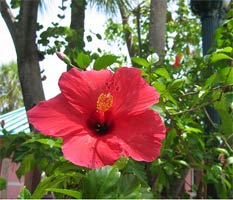 This flower symbolizes the beauty, tranquility and enjoyment of the tropics. Luxurious and extraordinarily lively, it personifies the memories of the sun, sand and islands in the distant sea. Hibiscus is one of the most colorful flowers in the world.
This flower symbolizes the beauty, tranquility and enjoyment of the tropics. Luxurious and extraordinarily lively, it personifies the memories of the sun, sand and islands in the distant sea. Hibiscus is one of the most colorful flowers in the world.
Hawaii has long been turned into a tourist paradise on the Pacific Ocean, it is here that one of the most exotic plants in the world is born. Hibiscus is found throughout the Hawaiian Islands and represents the beauty of life. The local rains and sun created excellent conditions for him. Hibiscus is one of the most famous flowers, it symbolizes peace and happiness, so in 1923 Hawaii chose it as its state symbol.
But even without official recognition, this flower is worthy of being admired. Hibiscus grows throughout the world, from tropical to temperate zones. Many growers can enjoy their own tropics during the winter by growing hibiscus indoors.
Amorphophallus (Leopard palm).
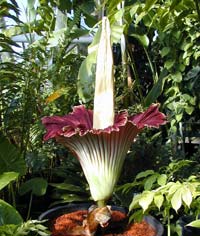 London has a botanical garden which is one of the oldest gardens in the world. So in this garden, since 1889, they have been growing (Amorphophallus titanum), which is popularly called the umbrella palm or leopard palm. Why leopard? Yes, because almost the entire peduncle and bract are covered with white and brown spots resembling leopard spots. Despite the fact that it has been grown here for quite a long time, this plant bloomed only 5 times. In general, there is nothing surprising here, because the height of this plant reaches 2 meters, by the way, the diameter of a leopard palm tree can also approach this value.
London has a botanical garden which is one of the oldest gardens in the world. So in this garden, since 1889, they have been growing (Amorphophallus titanum), which is popularly called the umbrella palm or leopard palm. Why leopard? Yes, because almost the entire peduncle and bract are covered with white and brown spots resembling leopard spots. Despite the fact that it has been grown here for quite a long time, this plant bloomed only 5 times. In general, there is nothing surprising here, because the height of this plant reaches 2 meters, by the way, the diameter of a leopard palm tree can also approach this value.
In ornamental gardening, plants are grown that are somewhat smaller, but also impressive, because the height of the flowers can reach 70 cm. Such a plant is called Amorphophallus riviera(Amorphophallus rivieri), it belongs to the aroid family. This family includes about 100 species of univalent plants, with dormant stages. The name of the entire family comes from the Greek word AMORFUS, which means shoot or process.
The world of flora is very rich and diverse. Mankind is constantly interested in plant life. Exotic flowers receive a lot of attention. They amaze with their beauty and sophistication. More recently, people knew only a few names of flowers, and at the present time, stores offer the consumer a huge selection of interesting plants.
Gorgeous bouquet
Girls and women are very fond of flowers, this is the best gift for the soul and heart. They delight the eye with their presence, fill the house with freshness and beauty. When exotic flowers are present in the bouquet, it becomes even more chic and original. Allows a person to see a piece of another continent.
Now it is not difficult to find any plant in flower shops. Florists can talk about them, tell you how to make a composition correctly, advise which flowers will look best, with which you can express your feelings. Such a gift is perfect for people who are hard to please. It is unusual, bright and unforgettable!
Plants of Mexico and Africa
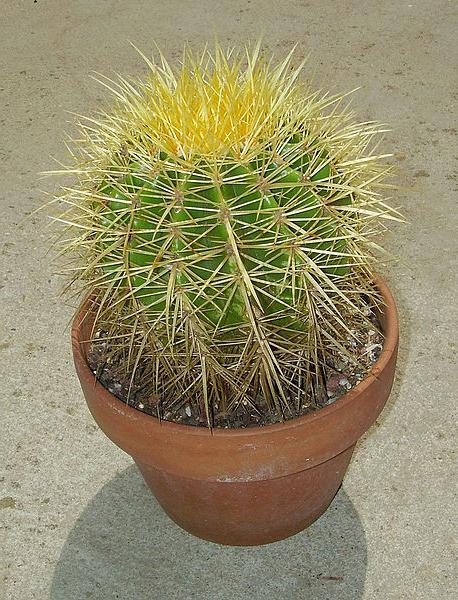 Not many people know the name of exotic flowers, they choose them simply by appearance: color, shape. You can buy original bouquets both in stores and via the Internet. The most diverse assortment with a complete description of the plant is offered.
Not many people know the name of exotic flowers, they choose them simply by appearance: color, shape. You can buy original bouquets both in stores and via the Internet. The most diverse assortment with a complete description of the plant is offered.
Flowers of Mexico:
Echinocactus Gruzoni. Requires proper care: the brightest possible lighting at any time of the year, moderate temperature and watering. The plant has the shape of a ball, up to 5 cm in size.
Spreckel. Genus Amaryllis, leaves are flat green. The flower is usually one, red. The plant is picky about air humidity, but requires a lot of light. He likes warm settled water, it is important to pour it into the pan without getting on the bulb.
Exotic flowers native to Africa:
Lithops or "living stones". They belong to the Aizoon family, of which there are more than 60 varieties. You need constant sunlight, the roots do not tolerate a lot of liquid. In the summer it is better to place them outdoors.
Gudia. The height of the shrub is about one meter, the stems are surrounded by thorns. It is worth avoiding the gulf of roots, and in winter it does not require water at all.
Original plants can improve the atmosphere of the room
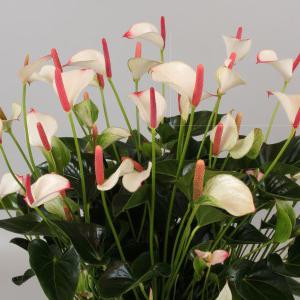 People always strive to learn new flowers, to grow them in their homes. Exoticism attracts lovers as much as possible, the unusual shape and smell of the plant generates interest. The range of colors in stores is expanding more and more. Bright and from India, America, China and other overseas countries are in good demand. Home exotic flowers, to the best of their ability, improve the air in the room, moisturize it, fill it with freshness and a pleasant smell.
People always strive to learn new flowers, to grow them in their homes. Exoticism attracts lovers as much as possible, the unusual shape and smell of the plant generates interest. The range of colors in stores is expanding more and more. Bright and from India, America, China and other overseas countries are in good demand. Home exotic flowers, to the best of their ability, improve the air in the room, moisturize it, fill it with freshness and a pleasant smell.
Palm, citrus and help get rid of harmful substances in the house. The air is purified, the microclimate is normalized. For example, anthurium is a flower native to Central and South America. Reduces the content of microbes in the indoor air. Several varieties of anthurium are known, all have different bud colors: pink, red, white and burgundy. The plant does not tolerate cold and direct sunlight, it is best placed on a window that faces southwest or southeast.
at home
Many breed exotic on their balconies and terraces. This gives beauty and a sense of nature to the apartment. It also creates an atmosphere of relaxation, helps to touch the world of flora of foreign countries. Some exotic flowers require special care and attention. Others, on the contrary, are quite picky and quickly adapt to any conditions.
IN indoor cultivation pachistachis yellow is very common. It originates from Tropical America. The shrub can grow up to one meter, has oval dark green leaves. The flowers are white, they fall off quickly, but bright yellow or orange bracts remain. The plant requires abundant watering on hot summer days. The ideal place is an east or west window, needs bright lighting.
Cyclamen home or alpine violet
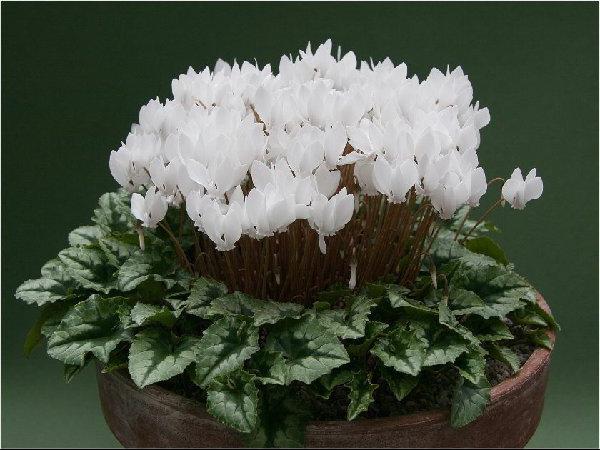 In general, people like plants that are easy to grow, disease resistant and easy to get used to in a new place. Exotic flowers in pots are now not uncommon, they are easy to buy in salons. Domestic cyclamen is very popular among the people; it grows in Turkey and the Middle East.
In general, people like plants that are easy to grow, disease resistant and easy to get used to in a new place. Exotic flowers in pots are now not uncommon, they are easy to buy in salons. Domestic cyclamen is very popular among the people; it grows in Turkey and the Middle East.
The height of the plant itself reaches 30 cm, large flowers of orange, white, lilac, pink and red. In the summer, cyclamen rests, in the fall it releases new leaves and buds. In winter, the plant begins to bloom, therefore it is very often a gift for new year holidays. Cyclamen does not like heat very much, so you should keep it away from a heat source (fireplace, battery). It is desirable to water in the pan, if water gets on the plant, rotting may begin.
Jasmine: lovely scent
Everyone likes a pleasant smell in the room. Exotic indoor flowers are sources of amazing fragrances. When choosing a plant for the house, we try to combine beauty and pleasant smell as much as possible. Jasmine is a prime example, it belongs to the olive variety, more than three hundred species are known. The birthplace of the flower is Asia and Australia. 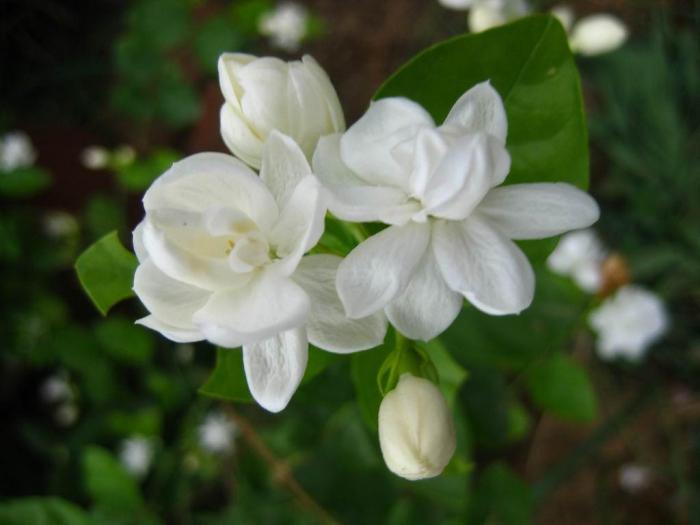
The following types are suitable for home breeding:
Jasmine officinalis;
hololithous;
Multicolored.
In winter, the plant should not be flooded with water, and in summer, during the period of growth and flowering, on the contrary. Jasmine is very afraid of drafts, loves light and fresh air.
All flowers, especially exotic ones, need proper care, it is advisable to first ask about their preferences.